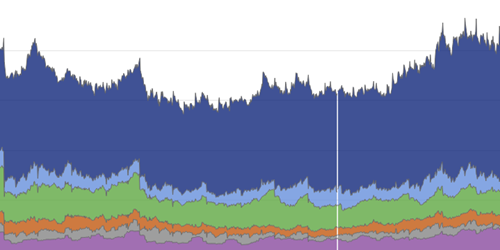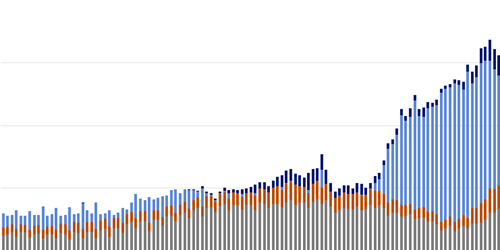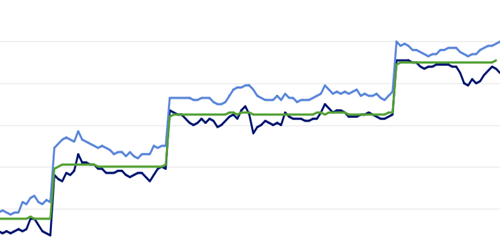OFR Short-term Funding Monitor
Short-term funding markets are the core of liquidity and maturity transformation in financial markets. They provide financing for financial institutions, serve as alternatives to deposits for cash investors, and can be used to obtain securities. However, as unavoidable consequences of their functions, these critical markets are vulnerable to disruptions. Problems faced by financial institutions or other parts of the financial system often appear as stresses in short-term funding markets. As part of the Office of Financial Research’s mission to promote and monitor financial stability, the OFR collects a variety of data on these markets. The Short-term Funding Monitor presents these data and places them in context with other data sources.
Market Digests
To allow for easier monitoring of conditions in short-term funding markets, the OFR offers sets of curated charts that provide insights into different dimensions of these markets. These market digests are broken down into four categories that describe how short-term funding markets are functioning: collateral, tenor, volume, and rates.
Repo transaction volumes by venue
Transaction volumes in repo broken out by venue
Skip the ChartThe market for repurchase agreements (repo) supports short-term liquidity and price discovery by allowing financial institutions to lend or borrow cash, usually overnight, with securities as collateral. Repo venues vary on the extent to which participants know their counterparty, the extent to which they know the specific security being used as collateral, and whether their trades are cleared by a central counterparty.
The OFR currently receives data on three venues for repo transactions. The first is the tri-party market. In tri-party repurchase (repo) transactions, participants know their counterparty, but transact against classes of collateral, rather than specific securities. As a result, tri-party repo is used only for financing, and not for obtaining specific securities. A custodian, usually a bank, maintains post-trade processing activities such as collateral selection, payments and deliveries, custody of collateral securities, and collateral management.
Borrowers in tri-party tend to be larger dealers to which cash lenders are willing to be directly exposed. The Federal Reserve has used tri-party repos on occasion to deliver liquidity to dealers in times of market stress.
The second venue is the Fixed Income Clearing Corporation's (FICC) DVP Service. This is a centrally cleared market in which participants know the specific security used as collateral for a transaction. It contains both unbrokered activity, where participants know their ultimate counterparty, and brokered activity, where participants do not know their ultimate counterparty. Because DVP Service settles on a specific-security basis, some of the activity surrounds securities that lenders want, using the market to gain temporary ownership of the security.
The third venue is FICC's GCF Repo Service. This is a centrally cleared market in which participants know neither the specific securities used as collateral nor their counterparty in a transaction. The venue is
purely general collateral, so all activity is financing driven. Because it is counterparty-blind, it can be a popular venue for participants concerned about revealing their immediate liquidity needs.
In April 2024 additional historical data was added for DVP and GCF from May 7, 2018. Previously data was only available from December 2019. Due to differences in the timing of data retrieval, this digest may update with a lag relative to the underlying series displayed.
Market Digest Categories
Each category contains a set of charts that present relevant data from our collections and other data sources and offers interpretative guidance from our research staff.
Collateral: securities held by a lender against the possibility that a loan defaults



Access Data
- U.S. Money Market Funds Office of Financial Research estimates of the holdings of U.S. money market funds
- U.S. Repo Markets Office of Financial Research estimates of activity in tri-party and centrally cleared repo markets
- Reference Rates Reference rates produced by the Federal Reserve Bank of New York, with related information
- Primary Dealer Statistics Data on primary dealers’ market activity produced by the Federal Reserve Bank of New York
- Treasury Constant Maturity Rates U.S. Treasury Department reports of daily constant maturity rates on Treasury securities
This OFR monitor is presented solely for informative purposes and should not be relied upon for financial decisions; it is not intended to provide any investment or financial advice. If you have any specific questions about any financial or other matter please consult an appropriately qualified professional. The OFR makes no warranty, express or implied, nor assumes any legal liability or responsibility for the accuracy, completeness, reliability, and usefulness of any information that is available through this website, nor represents that its use would not infringe on any privately owned rights.
Disclaimer Regarding Non-OFR Data and InformationFor convenience and informational purposes only, the OFR may provide links and references to nongovernment sites. These sites may contain information that is copyrighted with restrictions on reuse. Permission to use copyrighted materials must be obtained from the original source and cannot be obtained from the OFR or from the U.S. Treasury Department. The OFR is not responsible for the content of external websites linked to or referenced from this site or from the OFR web server. The U.S. government, the U.S. Treasury Department, the Financial Stability Oversight Council, and the OFR neither endorse the data, information, content, materials, opinions, advice, statements, offers, products, services, presentation, or accuracy, nor make any warranty, express or implied, regarding these external websites. Please note that neither the U.S. Treasury Department nor the OFR controls, and cannot guarantee, the relevance, timeliness, or accuracy of third-party content or other materials. Users should be aware that when they select a link on this OFR website to an external website, they are leaving the OFR site.
Suggested CitationOffice of Financial Research, “OFR Short-term Funding Monitor,” refreshed daily, https://www.financialresearch.gov/short-term-funding-monitor/ (accessed ).